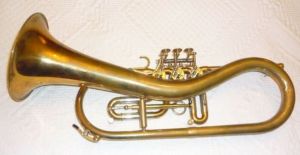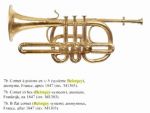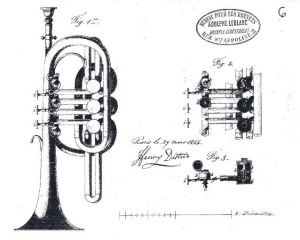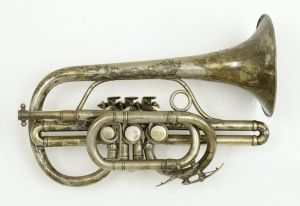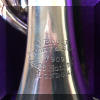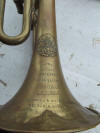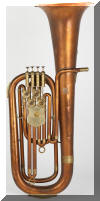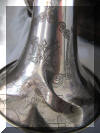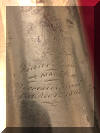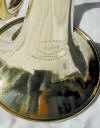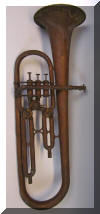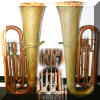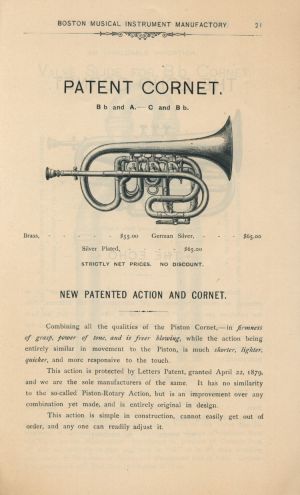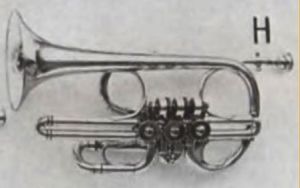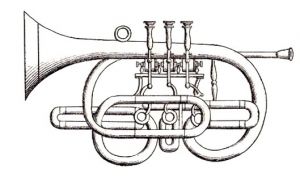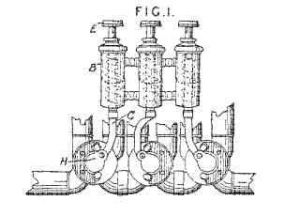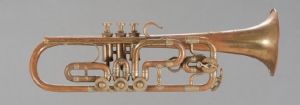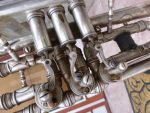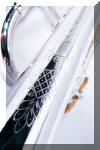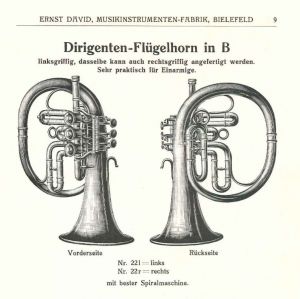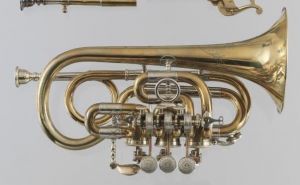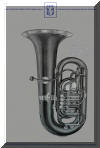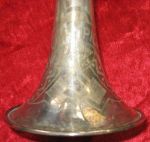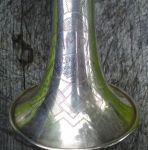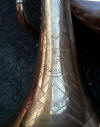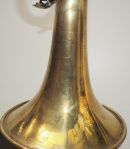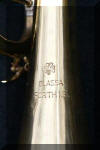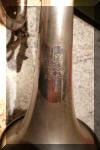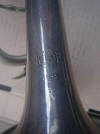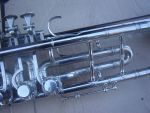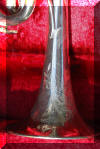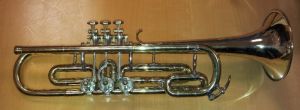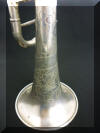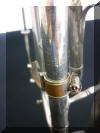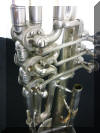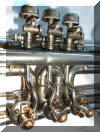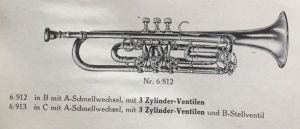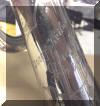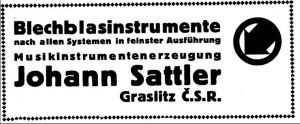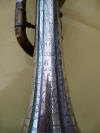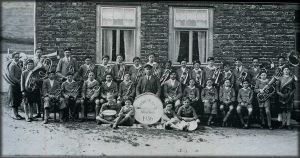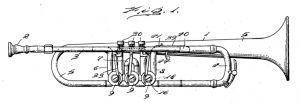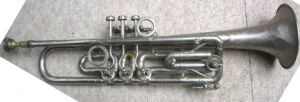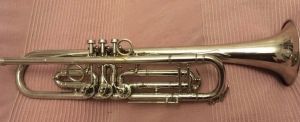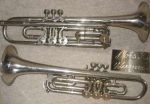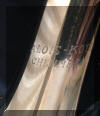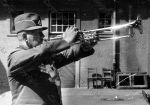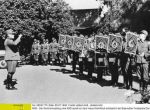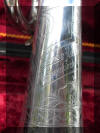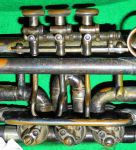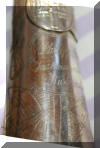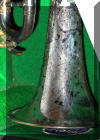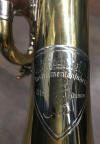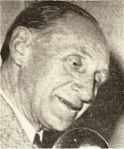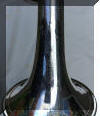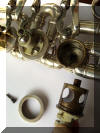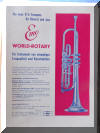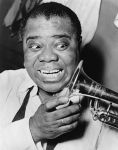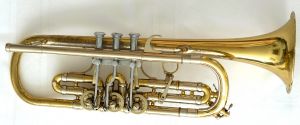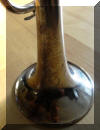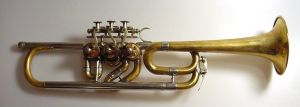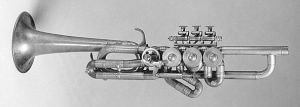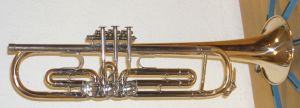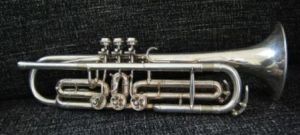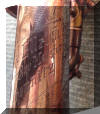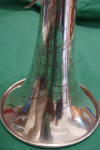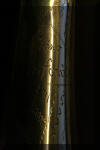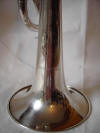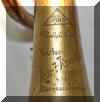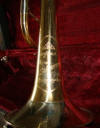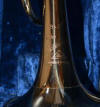Difference between revisions of "Top action rotary valve trumpets"
Gwesterhof (talk | contribs) (→Helmut John, Erfurt, Germany) |
Gwesterhof (talk | contribs) (→Rino workshop: Kurt Knoth and Johannes Scherzer, Markneukirchen) |
||
| Line 846: | Line 846: | ||
<gallery widths="150" heights="150"> | <gallery widths="150" heights="150"> | ||
| − | + | File:Kurt Knoth Rino Sinfonia SG66.jpg | |
| − | + | File:Kurth Knoth Sinfonia SG66 1 small.jpg | |
| + | </gallery> | ||
| + | <small> Rino Modell SG 66 Meister Kurt Knoth Sinfonia Markneukirchen, coll. Mark</small> | ||
Johannes Scherzer made a well known tarv trumpet, the SG66. According to Mario Weller, Johannes Scherzer started in 1963 with the SG63 prototype. The abbreviation SG refers to the names of the two main actors in the development of SG 63 and SG 66, Johannes Scherzer and his colleague Günther Grüllich. Further development led to the SG66 in 1966, that was produced untill 1996. The first instruments appeared under the name Kurt Knoth. The Scherzer workshop in 1984 became part of the VEB Blechblas- und Signalinstrumentenfabrik (B&S). Scherzer used serial numbers as of 1965, then he used another system within PGH Sinfonia as of 1972 till 1992. Then the number system of VMI (now B&S) was used, Weller states. The price of a new one in brass was DM 2632. | Johannes Scherzer made a well known tarv trumpet, the SG66. According to Mario Weller, Johannes Scherzer started in 1963 with the SG63 prototype. The abbreviation SG refers to the names of the two main actors in the development of SG 63 and SG 66, Johannes Scherzer and his colleague Günther Grüllich. Further development led to the SG66 in 1966, that was produced untill 1996. The first instruments appeared under the name Kurt Knoth. The Scherzer workshop in 1984 became part of the VEB Blechblas- und Signalinstrumentenfabrik (B&S). Scherzer used serial numbers as of 1965, then he used another system within PGH Sinfonia as of 1972 till 1992. Then the number system of VMI (now B&S) was used, Weller states. The price of a new one in brass was DM 2632. | ||
| − | + | <gallery widths="150" heights="150"> | |
| + | File:Kurth Knoth SG66 small.jpg | ||
| + | File:Kurth Knoth SG66 1 small.jpg | ||
| + | </gallery> | ||
| + | <small>Rino Modell SG66 Meister Kurt Knoth Markneukirchen</small> | ||
| − | + | [[File:Rino Scherzer SG 66 21199 Strupis small.jpg|thumb|center|<small>Rino Modell SG66 Meister Scherzer Markneukirchen serial nr. 21199 </small>]] | |
| − | + | [[File:Scherzer 21201 SG66 small.jpg|thumb|center|<small>Rino Modell SG66 Meister Scherzer Markneukirchen serial nr. 21201</small]] | |
| − | + | [[File:Rino Modell SG 66 Meister J Scherzer Markneukirchen HUC small.jpg|thumb|center|<small>Rino Modell SG 66 Meister J. Scherzer Markneukirchen serial nr. 21207, 1975</small>]] | |
| − | + | [[File:Scherzer SG66 23313 small.jpg|thumb|center|<small> Scherzer SG66 serial nr. 23313</small>]] | |
| − | + | <gallery widths="150" heights="150"> | |
| + | File:Scherzer 23864 SG 66 small.jpg | ||
| + | File:Scherzer 23864 SG 66 1 small.jpg | ||
| + | </gallery> | ||
| + | <small>Rino Sinfonia Meister J. Scherzer serial nr. 23864, ca 1972-1975 Markneukirchen</small> | ||
| + | |||
| + | <gallery widths="150" heights="150"> | ||
| + | File:J Scherzer Rino Markneukirchen SG66 1985 24340 (2).jpg | ||
| + | File:J Scherzer Rino Markneukirchen SG66 1985 24340 small.jpg | ||
| + | </gallery> | ||
| + | <small>B&S Meister J. Scherzer Rino SG66 serial nr. 24340, 1985 source: Ebay</small> | ||
| − | |||
Scherzer also designed an Eb alto model (a fifth below the Bb trumpet) a Bb tenor (an octave below the Bb trumpet) and a Bb bass model with the SG valve block. And then there was a special model in Bb/Eb. Although they have basically the same layout, these are not trumpets, but they are named 'fanfare'. They are used in a special type of German orchestras, the Fanfarenzug. Scherzer had a Geschmacksmuster, a kind of design patent, registered on this design in GDR times, according to Mario Weller. That protected the design for three years from 1968. | Scherzer also designed an Eb alto model (a fifth below the Bb trumpet) a Bb tenor (an octave below the Bb trumpet) and a Bb bass model with the SG valve block. And then there was a special model in Bb/Eb. Although they have basically the same layout, these are not trumpets, but they are named 'fanfare'. They are used in a special type of German orchestras, the Fanfarenzug. Scherzer had a Geschmacksmuster, a kind of design patent, registered on this design in GDR times, according to Mario Weller. That protected the design for three years from 1968. | ||
Revision as of 22:26, 31 May 2019
Top action rotary valve trumpets
Upright rotary valve trumpets push rod activated or piston activated rotary valve trumpets
Zylinder-Jazz-Trompete, Vertikaltrompete, Federstechertrompete
Trompettes a palettes verticales
The top action rotary valve trumpet (tarv), or upright rotary valve trumpet (German: Zylinder-Jazz-Trompete, Drehventil Jazz-trompete, Vertikaltrompete) has gained renewed popularity with Mnozil Brass' Thomas Gansch playing the Schagerl made Gansch-horn. Trying to combine the advantages of a rotary valve with the outlook of a perinet trumpet has a long history, going back till the 19th century. On this page I collected images of the old and the new ones, along with the information I could find about their makers. From the early 19th century inventions to the jazz inspired design in the roaring twenties, from the East German post war dance orchestra models to the recent novelties of Schagerl, Possegger and others.
Contents
- 1 19th Century tarv trumpets
- 1.1 Carl August Müller, Mainz (G)
- 1.2 Nicolas-Paul Belorgey sr, Paris FR
- 1.3 Henry Distin, London, UK
- 1.4 Boose Boosey London GB
- 1.5 Joseph Higham, Manchester, UK
- 1.6 Isaac Fiske, Worcester, United States
- 1.7 Henry Esbach, Boston
- 1.8 Pierre Piatet, Lyon, France
- 1.9 Hermann Trapp, Neukirchen, Bohemia
- 2 20th Century pre-WWII tarv trumpets
- 2.1 Léon Moeremans, Ghent, Belgium
- 2.2 Rewo
- 2.3 Robert Barth, Stuttgart GE
- 2.4 Ernst David, Bielefeld, Germany
- 2.5 V.F.Červený & S.(ynové), Hradec Králové, Czechoslovakia
- 2.6 F.X. Hüller, Graslitz, Czechoslovakia
- 2.7 Glassa, Fürth, Germany
- 2.8 Bohland & Fuchs, Graslitz, Czechoslovakia
- 2.9 Franz Spengler, Nürnberg, Germany
- 2.10 Const. Riedl, Nürnberg, Germany
- 2.11 C.A.Wunderlich, Siebenbrunn, Germany
- 2.12 Robert Oswald Adler, Markneukirchen, Germany
- 2.13 Anton Riedl - Arigra, Graslitz, Czechoslovakia
- 2.14 Josef Keilwerth, Graslitz, Czechoslovakia
- 2.15 Johan Sattler, Graslitz, Czechoslovakia
- 2.16 Star Supertone
- 2.17 Kielbich & Sattler
- 2.18 Nathan Einhorn, Philadelphia US
- 2.19 Ant Janda, Hodonín, Czechoslovakia
- 2.20 Josef Dotzauer, Graslitz Czechoslovakia
- 2.21 Alois Kotek, Chlumec nad Cidlinou, Czechoslovakia
- 2.22 Alois Zmitko, Louny, Czechoslovakia
- 2.23 Johannnes Adler, Markneukirchen Germany
- 2.24 Philip Reichel, Markneukirchen, Germany
- 2.25 W. Ed. Voigt Jun. Markneukirchen
- 2.26 J. Mollenhauer & Söhne, Fulda, Germany
- 2.27 Christian Reisser, Ulm an der Donau, Germany
- 2.28 Julius Rudolph, Gotha, Germany
- 3 20th Century post-WWII tarv trumpets
- 3.1 Ernst Modl, Neustadt a.d. Aisch, Germany
- 3.2 Miraphone, Waldkraiburg, Germany
- 3.3 Kurt Scherzer, Augsburg, Germany
- 3.4 Helmut John, Erfurt, Germany
- 3.5 Helmut Seifert, Chemnitz, Germany
- 3.6 Felix Ellrich, Karl Marx Stadt, Germany
- 3.7 Rino workshop: Kurt Knoth and Johannes Scherzer, Markneukirchen
19th Century tarv trumpets
Valves were invented in the early 19th century. There's a lot written about the development of this invention, that occurred on different places, instrument makers copying and improving each others designs. In 1818 Heinrich Stölzel (1777 - 1844) and Friedrich Blühmel (1777 - 1845) were granted a patent in Germany for a piston valve horn. The second valve design which was widely used in Germany was the rotary valve, produced as early as 1824 by Nathan Adams (1783-1864) of Boston and patented in 1835 by Joseph Riedl in Vienna. In this design the piston turned in the valve casing instead of moving vertically, allowing a very consistent bore. Although rotary valves are difficult to disassemble for maintenance, this type of valve was to become the standard design used on horns in Germany by the late nineteenth century. The other significant development was an improved piston valve invented in 1838 or 1839 by brass instrument maker François Périnet of Paris. His design featured faster action and a tubing arrangement superior to the older Berlin valve design. While the Périnet piston valve was frequently used in France and England and the US, it was seldom used in Germany.
Carl August Müller, Mainz (G)
One early example of an top action rotary valve instrument is this cornet by Carl August Müller in the collection of MusikMuseum Basel (S). Carl August Müller (Adorf 11 Jan. 1804 - Mainz 27 Jan. 1870) was educated in Vogtland, settled around 1824 in Mainz and established his own workshop C. A. Müller Musikinstrumenten-Fabrik in 1827. He invented amongst others what's called the Mainzer valve. The cornet below has levers that actuate the rotary valves.
Tarv cornet with slides, coll.: MusikMuseum Basel, photo: JunWha Shin
Nicolas-Paul Belorgey sr, Paris FR
Although perinet valves are popular in France, an early system of top action rotary valves came from french valvemaker (pistonnier) Nicolas-Paul Belorgey. Having worked for most of the Paris makers of the middle of the 19th century, he obtained an 1847 patent for a valve in which the cylinder is controlled by a small valve with a coil spring.
The MIM in Brussels has a cornet in Bb with these ‘vertical’ valves (á moteur vertical):
Left: the MIM cornet, on the Museum site Belorgey is the maker. MIM employé Géry Dumoulin described it in his book 'Cornets a pistons' (2001) as an 'anonymous' instrument with the Belorgey system (right)
Henry Distin, London, UK
Another early push rod top action rotary valve instrument is a cornet by Henry Distin in London. The Distin family where famous musicians and were Adolphe Sax's agents for the sale of his instruments in Britain as of 1846. In 1850 Henry took over the business from his father as Distin & Co. and as of 1851 they started making instruments themselves. In 1854 (March 27th) Distin patented a rotary valve cornet with tension springs in barrels in France. This cornet arrangement was registered in Britain as a design in the same year. The patent drawing shows a rotary-valve cornet constructed in such a way that (according to Distin) it can be easily demounted. The cleaning of the instrument and the replacement of the springs can thus be performed by the player. Only one surviving instrument made according to this patent is known, a cornet (serial number 1105) in the Ontario Museum, Toronto.
Strangely, Distin’s 1857 catalogue does not include any cornets following this system.
The Musical Instruments Museums Edinburgh has a silver-plated Henry Distin cornet with top action rotary valves in their collection, dated 'probably circa 1857'. It corresponds to the "Perpendicular rotary cornet" in Henry Distin's 1857 catalogue.
Boose Boosey London GB
C Boose Boosey & Sons Holles St London, serial number 7902, dated around 1850. Source Ebay.co.uk 2017
A silver B flat cornet by Carl Boosé (1815-1868), who was employed by Boosey as a band music editor and wind instrument tester. T. Boosey & Co. were advertised as ‘agents for his military band instruments’. The Boosey company became big-time players in the brasswind market at a stroke in June 1868 by the purchase (for £9700) of Henry Distin's instrument factory.' Before that, their brass production had been either small or outsourced, but they did have a substantial customer base as instrument dealers. Several instruments survive inscribed with both "C. BOOSE" and either "BOOSEY & SONS" or, latterly, "BOOSEY & COMPY." Carl Boose, primarily a bandmaster and music publisher, died in August 1868. It is not known who actually made the instruments marked "C. BOOSE." Their design is similar to Distin's models: it is possible that they were made in the Distin factory; but they could have been continental imports, or Carl Boose could have operated his own workshop. The early stockbooks show that the brass instruments being sold by Boosey & Co.at the time of the acquisition of the Distin factory were nearly all going to bands and other customers. Since few were sold to dealers it is probable that Boosey & Co were themselves largely or entirely dealers in brasswind. This was not the case with woodwind, where Boosey & Co. were already established makers. (source: Arnold Myers, Brasswind Innovation and Output of Boosey & Co. in the Blaikley Era)
Joseph Higham, Manchester, UK
The idea of combining rotary valves with top piston action was patented in 1857, Jan. 15th, by Joseph Higham of Manchester, England (GB # 123). The patent expired three years later because Higham didn't pay the £50 needed for prolongation.
coll. Trompetenmuseum Bad Säckingen
Higham (b. Manchester 1818; d. Manchester 1883) established his firm in 1842. The company was making instruments for the Army and Navy and exported them as well. Higham's cornets had a valve system which consisted of a piston traveling through what appears as a valve casing, operating a rotary valve. These valves are much like those of Isaac Fiske, who patented the idea much later in 1866 in the United States. Higham also made a bariton with a valve system like this.
Isaac Fiske, Worcester, United States
Isaac Fiske, instrument maker from Worcester, Massachusetts, patented a push rod cornet, the first patent is dated October 30, 1866. February 11th, 1868 he was granted a patent for an improvement of his invention (patent US74331). 19th-Century American rotary valves used a string linkage while in Higham's valves as in German rotary valves the connection between touch piece and rotor takes the form of metal levers. The novelty that Isaac Fiske patented was the integration of a piston action with a string rotary-valve design, a straight, up-and-down movement of the push rods instead of the arcing motion of normal rotary valves. In an 1868 catalog Fiske offers this system for Bb and Eb cornets ($60 for the brass ones, $5 more than his piston valve cornets) but also for tenor horns. As Robb Stewart from Arcadia, California, puts it, it was his answer to the change of fashion in cornets. Fiske was loosing market share both because the mode was increasingly French style cornets. He designed a rotary valve mechanism that put the instrument in the same ergonomic position as those with Perinet piston valves. These pushrod actuated valves had the added benefits of a shorter stroke and the mechanical and acoustical qualities of his other instruments.
Isaac Fiske Bb cornet in Illustrated catalog of Musical Instruments 1868 and a picture from this instrument source: Excelsior Cornet Band
Isaac Fiske Eb cornet and Bb tenor
Isaac Fiske cornet, probably Bb, source Ebay.com 2015
Isaak Fiske cornet with spring and valve inverted. On the bell the Nov 12th 1867 patent is mentioned
He is known to have offered cornets built with this configuration in catalogs printed in 1873 and 1881. On the Eb cornet below with triangular arranged valves other patents are mentioned, dated April 29th, 1873 (triangularly arranged valves)/November 12th, 1867 (an improved crook). A patent dated September 23rd, 1873 shows an another improvement (concentric curves in the valve casings). The Fiske museum (now moved to the Musical Instrument Museum (MIM) in Phoenix) has a Bb cornet as well as does William Hull Faust, from Columbus Ohio.
Ebay.com (tenor) HUC (tuba)
Isaac Fiske made a tenor horn and Bb/Eb tuba with a similar valve configuration
The Fiske patent was used by Frederick Beaumont, who had worked for Isaac Fiske. In partnership with George McFadden he produced unlicensed copies of Fiskes patented designs. The ensuing squabble with Fiske forced McFadden & Beaumont out of business within two years. Only one known instrument is left.
[[File:McFadden & Beamont c 1872 small.jpg|thumb|McFadden & Beaumont tarv cornet, ca 1872, source: Excelsior Cornet Band
19th century American rotary valves used a string linkage while German rotary valves had a metal levers to connect touchpiece and rotor. Here's a typical E. Seltmann tarv cornet demonstrated by Cris Larios from Kansas City. Ernst Theodor Seltmann (1828 - 1883) came from Neukirchen, Saxony and had emigrated to the U.S., arriving at the port of Baltimore on June 29, 1857. Establishing himself as a brass instrument maker in Philadelphia, he flourished there through the Civil War and thereafter until his death. The National Music Museum in Vermillion owns several of these top-action string operated rotary valve instruments. They were popular in the US in the second half of the 19th century. I'll leave them aside on this page. Just one more
Henry Esbach, Boston
In 1879 Henry Esbach from Boston patented a top action rotary valve cornet. Esbach was one of the owners of The Boston Musical Instrument Manufactory. This company of makers was a merging of the E.G. Wright and Graves & Co. shops and originated in 1869. Robb Stewart has gone deep into the different cornets of The Boston MIM on his site.
- Error creating thumbnail: File with dimensions greater than 12.5 MP
Henry Esbach patent tarv cornet, source RobbStewart.com
Pierre Piatet, Lyon, France
Two top-action instruments made by Pierre Piatet. Piatet (ca. 1796 - 1868) established his own firm in Lyon after 1836. He also worked with Benoit to about 1855 in their firm called Piatet et Benoit.
Antoine Courtois in Paris had a similar cornet design.
Hermann Trapp, Neukirchen, Bohemia
Hermann Trapp (b. 1855- ) was a (string) instrumentmaker in Neukirchen, Bohemia (now Nový Kostel, Czechia). In a Hermann Trapp catalog from around 1890 there's a tarv cornet in B(b) and C listed.
20th Century pre-WWII tarv trumpets
Léon Moeremans, Ghent, Belgium
Léon Moeremans (Ninove 22 december 1861 – Gent 12 augustus 1937) was a Belgian composer, music pedagogue, conductor, music retailer (brass instrument maker and piano builder) and music publisher. Since 1899 he built trumpets, cornets and bugles; furthermore he had patent rights on valves for brass instruments.
One was a Great Britain patent numbered 161,566 and dated April 6, 1920. It describes a top action rotary valve. In a rotary valve (H) of a brass or like wind musical instrument, of the kind operated by means of a spring- controlled piston-push (E, B), one end of the connecting link (C) embraces a pivot-pin passing diametrically through the piston B, while the other end is connected directly with the rotary valve. An example, a Bb trumpet with an additional A valve is preserved in the Muziekinstrumentenmuseum in Brussels. The patent was also registered in France (no.531855), Germany (353829), Switzerland (96330) and Czechoslavakia (10027).
Rewo
A tarv trumpet offered on a Czech auction site has more or less the same valve construction. The model is named Rewo, it has a pre-war look and that's all I can say now.
Rewo trumpet, source: Aukro 2015
The instrument was overhauled by Jan Vundr ('Brassmaniac'), from Liberec, Czech Republic and offered for sale through Ebay in February 2016.
Rewo overhauled, source Ebay.com 2016
Robert Barth, Stuttgart GE
Robert Barth who started a workshop in 1878 in Stuttgart, claims in a catalog that he was inspired to develop a new top action rotary valve construction after his engagements in workshops in Paris and Lyon. He called it System Barth. Lighter, less noise, shorter valve stroke and to operate with one hand (which can't be done with the usual rotary valve construction).
Ernst David, Bielefeld, Germany
In a catalogue around 1925, Albert David advertises this flugelhorn with top action rotary valves. Albert is the son of Ernst David who together with Johann Kuhlo developed the Kuhlo horn, a more or less circular rotary valve flugelhorn, designed for the use in the German 'posaunenchor'. The above flugel is meant to be played with one hand by the director of an orchestra, but also advertised as a good option for one armed musicians.
V.F.Červený & S.(ynové), Hradec Králové, Czechoslovakia
Václav František Červený (1819-1896) was an ingenious Czech wind instrument designer. He established his workshop in 1842 in Hradec Králové (german: Königgrätz) and as of 1876 operated as V.F.Červený & Synové (Červený and Sons), with his sons Jaroslav, Stanislav and later Václav. Somewhere between 1900 and 1925 Červený made a type of top action rotary valve instruments. It's an 1873 patented feature of Červený instruments that was improved in 1878, their Walzenventile, or “roller valves”. This roller valve mechanism is basically rotary valves that have been rotated 90 degrees from their typical position. This was done to simplify the mechanism, by increasing the mechanical advantage of the lever system. The patent was
Červený roller valves, source: catalog 1896, found at R.J.Martz.
A cornet with these roller valves is in the collection of the Germanisches Nationalmuseum Nürnberg. It's dated around 1910.
In the collection of Karl Burri, Klingende Sammlung in Bern there's another one, dated around 1900
Červený made other instruments with these valves as well. A tenorhorn (or Kaiserbariton/euphonium) playing in Bb, with 4 rotary valves, was offered on Ebay in 2014. The size of the horn is approximately 30 inch/76 cm. The bell meassures 10,5 inch/27 cm. The University of Edinburgh als has one in it's collection. It has an inscription saying: V.F. Červený & Sons, Königgrätz - Bohemia, Europe / Sole Agent for United States: Louis Viták, Canton Ohio. Another euphonium is in the collection of Vince Simonetti as is a Bb tuba. The last one with Louis Vitak located in Chicago, Illinois.
Tenorhorn, V.F.Červený & S.(ynové), Hradec Králové, source: g.mu6, Ebay.com, 2014
R.J.Martz has a tarv french horn in his collection.
Instruments with these valves are still found in a catalog from 1925.
cornet, tenorhorn and Bb tuba from 1925 V.F.Červený & Synové catalog
Below is another tarv trumpet engraved V.F.Červený & S., Hradec Králové, model Champion. A fourth valve changes between (probably) Bb and A. When asked the V.F. Červený company (now an Amati subsidiary) said they believe the instrument was built between 1930 and 1950, because of the used valves and other parts, the engravings and decoration. As it's not in any of their old catalogs they think it might be a prototype or a custom made instrument. The instrument was sold on May 30, 2015 (for 295 Euro) and was offered on Ebay one week later by a seller who stated it was made between 1918 and 1925..... which is highly unlikely given the art deco-like engraving style.
V.F.Červený & S. tarv trumpet model Champion, source: Aukro.cz/Ebay.com 2015
What's interesting is that the engraving on the bell of the above Červený is identical to an engraving on a F.X. Hüller a Spol (& Co) Champion trumpet (apart from the 'makers' name). Champion was a model name used by F.X.Hüller (and later by his son-in-law Ernst Modl) as his basic model. Hüller also is known to have obtained a patent registration (D.R.G.M.) for a top action rotary valve design.
Identical engraving on F.X. Hüller a spol trumpet (l) and V.F Červený & S. tarv trumpet (r)
And here's a F.X. Huller Champion tarv trumpet, offered on Bazoš.cz in 2019. It has an extra loop to provide tuning in Bb and C (or A?). The seller (living some 240 km south east of Hradec Králové) dates it between 1930 and 1940. The engraving says: 'F.X.Hüller a spol, Kraslice' instead of 'F.X. Hüller & Co, Graslitz'. That could indicate that the instrument was meant for the Czech market and not for export.
F.X.Hüller Graslitz, Champion
F.X. Hüller, Graslitz, Czechoslovakia
In 1929 Franz Xaver Hüller obtained a Deutsche Reichs-Gebrauchsmuster (D.R.G.M.) registration for a top action rotary valve trumpet design (no. 1.088.742, September 4th, 1929). Franz Xaver Hüller was an instrument maker from Graslitz in Czechoslovakia (now Kraslice, Czechia). He was born on December 29th of 1856, in the nearby Pechbach. He founded his factory in 1882. By 1910 Hüller had 200-250 people at work. He built and traded wind instruments and stringed instruments, with branches in Markneukirchen and Klingenthal. From 1923 he also produced saxophones. In 1920 his daughters an his sons in law Anton Riedl and Ernst Modl became business partners and the name was changed to F.X. Hüller & Co. Hüller died in 1936. Modl also produced some tarv trumpets after WWII, see below.
The model was inspired by the jazz craze of those days, as was his Jazzophon. It was a way to adapt the rotary valve trumpet, common in the German speaking part of Europe, to the trumpet style used in (American) jazz, that used piston valves. In a F.X.Hüller catalog it's advertised as World-Glassa model. [[File:FX Huller catalog World Glassa.jpg|thumb|center|catalog FX Hüller p. 13 ca. 1930, source fxhuller.com
A fine example was offered on Ebay.de in 2018. It has D.R.P and D.R.G.M. on the bell as well as the name GLASSA in a trefoil.
Glassa DRP DRGM, source Ebay.de 2018
In the above mentioned catalog the patent (in fact two patents) are explained: a D.R.G.M. registration for the tarv valves and a Deutsches Reichs Patent for a new way of air passage through the valve. [[File:FX Huller catalogus p 10.jpg|thumb|center|catalog F.X. Hüller p 10, ca. 1930.The Zeitschrift für Instrumentenbau (Vol 50, p108) mentions a patent 1087753 for Hüller: 'Zylinder-maschine bei der die Zylinder in Quadratische Form angeordnet sind'. 23-7-1929
Now as to the the model name World-Glassa: World is another well known model name used by F.X.Hüller. There are quite some Glassa tarv trumpets known (see further below) that are pretty much identical to the one in this catalog, some of them marked Glassa, Fürth i.B. Glass was the name of an instrument maker in Fürth, a place close to Nürnberg in Bavaria. The New Langwill Index mentions an Emil Glass in Fürth in the first half of the 20th century. He might be the man behind the Glassa name. A hypothesis could be that Glassa built the tarv model trumpets for Hüller and also sold them under his own name.
Glassa, Fürth, Germany
Glassa, source: g.mu6 Ebay
Trumpet marked Glassa Fürth and also D.R.P. and H.F.S on the valves. D.R.P. could mean Deutsches Reichs Patent, a patent form that ended with the German Reich in 1945. The German patent register doesn't give a clue. It's not about the tarv system, because a 'normal' valve trombone from Glassa has the same D.R.P. inscription. The meaning of H.F.S is unclear to me.
Glassa Fürth i. B.
This is another top action rotary valve trumpet by Glassa. This instrument is commented on the website of a Bamberg band, saying that it might originate around 1940-50. It is suggested that the reason for making tarv trumpets was an economic one, makers wanting to respond to market desires and yet being able to keep using their rotary valve tooling and parts. (The comment also states that Glassa was renowned mainly as a repair workshop so the engraving might be the result of a repair job, which is obviously not true). In 2015 another Glassa, Fürth i.B. tarv was offered on German Ebay. Again the D.R.P. reference, in a trefoil.
source: Ebay.de 2015
And another one in 2017, with D.R.P and H.F.S trefoils.
source: Ebay.de 2017
And one more in 2017 , this time with only the HFS engraving...
source Ebay.de 2017
The DRP patent obviously is not only related to the Glassa tarv trumpets, here's an example of a rotary trumpet with the DRP signing in a trefoil
Ebay.de 2019
Bohland & Fuchs, Graslitz, Czechoslovakia
A very similar tarv trumpet is the B&F below. Bohland and Fuchs are established as a partnership in 1870, following the firm of Gustavus Bohland, which had been founded 20 years earlier, and flourished until 1945 when the firm was nationalized. By 1925, they had a workforce of 500. They were the first to use steam engines in their factory before WWI. Before WWII Bohland & Fuchs was one of the main brass instrument factories in Graslitz. During the war most factories were in the war industry. After the war, the production facilities of firms like B&F, Kohlert, Keilwerth, Hüller were merged into the AMATI cooperative (and in 1948 nationalized). This instrument is engraved with the B&F logo and a serial number 120584 on the bell.
B&F sr. nr. 120584, source g.mu6 Ebay.co.uk 2016
And an identical one with serial number 120552
B&F sr.nr. 120552 source: damienek, Ebay.de 2019
And another - unmarked - one from the same Polish seller, probably also B&F. Dated by him as 70 years old
unmarked tarv, source: damienek Ebay.de 2019
This unmarked tarv has valve rods, push buttons that look pretty much like the Červený and the B&F. The floral designs on the bell would date it even before the Červený.
source Ebay.de 2015
Another unmarked tarv shown on Trompetenforum has a Bb and a C bow, the Bb one having an extra loop. No engravings on the instrument. According to the poster the valve section instrument possibly comes from Graslitz and was build together in the Nürnberg area, at least 50 years ago on special request for a musician who doesn't remember the maker.
When it comes to the making of tarv trumpets, before World War II there seems to be focal point around Nürnberg. Tarv-trumpets are known from makers Franz Spengler and Constantin Riedl in Nürnberg, close to Fürth.
Franz Spengler, Nürnberg, Germany
Franz Spengler (10.11.1895 Graslitz - 13.08.1960 Nürnberg) was born in Graslitz. In the early twenties he settled in Nürnberg. He was a brass instrument maker, trader ans musician. The New Langwill Index mentions Franz Spengler being active in 1927. The Germanischen National Museum has one of his trumpets that they date around 1920. Frans Spengler Musikinstrumentenbau Nürnberg was located in the Wölkernstraße 29. In 1959 Spengler sold his workshop to Josef Klier.
Franz Spengler, ca 1930 Ebay sale 2012
Const. Riedl, Nürnberg, Germany
Konstantin Josef Riedl (Nürnberg 22-6-1869 - 19-1-1950) established his workshop in 1883. His son Konstantin Richard Riedl (Nürnberg 31-3-1900 - ? ) started in 1925. In 1930 the workshop was located at the address Hintere Kartäusergasse 5, according to the 'Buch der alten Firmen der Stadt Nürnberg' from that year. The address doesn't exist any more, maybe it disappeared in the WWII bombings that destroyed 80% of the Nürnberg centre. Riedl also is known as an instrument trader, it's not clear if he made this instrument. This instrument marked Const. Riedl Instrumentenmacher Nürnberg has a lot of similarities with the Spengler one.
Const. Riedl, Nürnberg, source Ebay
C.A.Wunderlich, Siebenbrunn, Germany
A tarv trumpet model was already offered around 1928 in a catalog of C.A. Wunderlich, an instrument trader from the nearby German Siebenbrunn (it says D.R.G.M. Sch.a, meaning 'protection applied for'). I'm not sure if this is referring to the Hüller D.R.G.M. application. The ad highlights two advantages of rotary valves: no failing valves and a short stop. The trumpet listed has no clock spring valves.
Here's the instrument as offered on Ebay.de in 2016.
C.A. Wunderlich Siebenbrunn Vogtl. source Ebay.de 2016
Robert Oswald Adler, Markneukirchen, Germany
In a catalog from 1930/1931 or shortly afterwards Robert Oswald Adler from Markneukirchen advertises a similar design, referring to the advantage of non-sticking valves, as Wunderlich did. Adler doesn't mention any D.R.G.M. registration. That could mean this catalog dates from 1932 or later, when the Hüller registration had expired. [[Jump to:navigation, search |thumb|center| catalog Robert Oswald Adler ca. 1930/1931]]
A D.R.G.M. registration is mentioned on the tarv trumpet below, that was offered on Ebay January 2014. It has no makers name but on the incomplete leadpipe there's D.R.G.M. engraved. But is different from the Hüller and the Wunderlich ones.
source Ebay 2014
Anton Riedl - Arigra, Graslitz, Czechoslovakia
Anton Riedl was born in 1861 and established his own company in 1885. Musikinstrumenten-Fabrik Anton Riedl was located at the Eibenbergerstrasse 835 in Graslitz (now: Wolkerova, Kraslice). Riedl was an accomplished maker of instruments, (rotary) valve blocks and bells and also a trader of other musical instruments. ARIGRA is an acronym for Anton RIedl GRAslitz. The Arigra trade mark is best known for it's octagonal bell trumpets. In 1931 Anton reached the age of 70 years as senior chef of his Musikinstrumentenfabrik in full physical and mental health, as the Zeitschrift für Instrumentenbau mentions. Riedl's son Hugo became partner in the Musikinstrumenten-Fabrik Anton Riedl from 17-01-1931 onwards (an OHG, Offene Handelgeselschaft). From 14-05-1938 Hugo Riedl is registered as the sole owner of Anton Riedl Musikinstrumenten-Fabrik, trade name Arigra. In a list of house owners in May 1945 Hugo is still listed at the address Eibenberger Strasse 835. After WWII Germans were expelled from what again became Czechoslovakia. In a list of German people that were expelled, Hugo is not mentioned, but Anna Riedl (49) is mentioned as owner of a factory, with a husband in Bavaria, departure provided by a train on October 11th 1946. With the formalisation of the creation of the Amati collective in June 1948 (working back till 1-1-1947) Anton Riedl was one of the confiscated companies and workshops involved.
Arigra top action rotary valve Bb trumpet with A valve, source: ebay.de 2015
A catalog 56 from Heinrich Hermann Dick in Markneukirchen offers a tarv in C with Bb valve and A extension. Dick was a trader, under the name Herdim. The catalog should be dated after 1922, because it refers to the Rudolf Mosse-Code that was implemented in that year.
Josef Keilwerth, Graslitz, Czechoslovakia
This clock spring tarv is marked Josef Keilwerth. Josef Keilwerth was an instrumentmaker in Graslitz. He was born in 1887. This instrument has to be dated before WWII because it uses the German name for Kraslice. 736 is the house number, Keilwerth lived and worked at the Berggasse 736 (now Na Kopečku 736, Kraslice). Beside this tarv trumpet a few rotary valve trumpets of his hand are know. In August 1946 he was expelled like most of the German population in the former Sudetenland after WWII. He was listed to leave by train to Bavaria, together with his wife Anna and daughters Margaretha and Gertrud.
Josef Keilwerth Graslitz 736, source Ebay 2014
Johan Sattler, Graslitz, Czechoslovakia
Johann Sattler was also a brass instrument maker in Graslitz. He was born in 1878. In 1904 he established his workshop, around 1938 he was still located at the address Silberbacherstrasse 23. In 1914 Sattler served in the Austrian Hungarian Army (the 6th Landsturm Regiment, a reserve force consisting of men aged 34 to 55). On the list of expelled people in 1946 only Julie (61) and Franzeska (26) are mentioned at this address. According to his granddaughter Johann died before the end of WWII. He was also active in the trade of musical instruments and strings.
Johann Sattler patented a trumpet with push-rods enclosed in metal tubes in Czechoslovakia, on November 1st, 1935, no. CZ 6296 - 35. He also patented this invention in the US (US 2,106,281 by Johann Sattler of Bohemia, Czechoslovakia), filed on August 15th, 1936 and approved on January 25th,1938. In his patent he claims that opening the valves only requires a very small movement of the plungers and therefore his invention permits quicker tone variations.
The Fiske Museum collection has another tarv trumpet by Johann Sattler, Graslitz, marked 'Patent Pending U.S.A.' (ca. 1937).
On September 22th 2018 the granddaughter of Johann Sattler showed in a broadcast of the Bavarian BR a Sattler JAZZMASTER which according to her was his masterpiece. It has blue and pearl valve tops and similar caps and extensive multi coloured art deco engravings. It was dated around 1910 by the experts on duty. Which would be in line with the then age of Sattler, but not with the use of the Jazzmaster name, because the use of the word jazz started later....
- Sattler jazzmaster meisterstuck 3 small.jpg
- Sattler jazzmaster meisterstuck 4 small.jpg
Jazzmaster, Johann Sattler Mus. Instr. Fabrik Graslitz, source BR.de
At an auction in Vichy (France) in 2007 a Sattler, Graslitz JAZZ MASTER trumpet was sold with similar blue and pearl valve tops. In november 2015 Jan Vundr ('Brass maniac') also sold a Jazzmaster that looked identical to the Sattlers, but with no other engravings than Jazzmaster (and without blue and pearls valve tops).
Jazzmaster source: Brassmaniac.com 2015
Star Supertone
Star Supertone coll. Gerard Westerhof
Practically identical is a trumpet marked Star Supertone with a 'K' in an art deco engraving. The bell rim mentions the Sattler U.S. and Č.S.R patents, on the reciever is 'Made in Czechoslovakia' engraved and a serial number 137. The valve caps have a blue star inlay in mother of pearl like the Sattler masterpiece above. Supertone was one of the tradenames used by Sears for their musical instruments, but the combination Star Supertone along with the K in the logo is unique sofar. Because of this K, my hypothesis is that the instrument might have been made by Sattler and sold by V. Kohlert and Sons from Graslitz, who is known to have made other 'Star' instruments for the American market, and sold in the US through Sears. But that's only a wild guess.
This instrument was sold in 2012 by Felicity Blastland, Swansea, UK, who got it in 1981 from a friend. His father, captain E.J. (Eric) Farmery, had owned it. Farmery was born in the late 1920’s and came from Selby in Yorkshire, UK. He was a jazz enthusiast and loved playing it. It's unclear where he picked up the horn, in the 1950's he was posted in Stuttgart, India and Singapore, so it probably went out there with him. The Edinburgh museum has an instrument without a makers name but on the bell the Czech CZ 6296-35 and US 2,106,281 patents engraved and also the Made in Czechoslovakia on the reciever ferrule, with serial number 130. The picture is mirrored.
Johann Sattler, Graslitz, source Ebay.com (US) 2018
Johann Sattler also made a one-valve one. Missing the valve cap and inscribed Patent applied for U.S. Patent Office. It is 22" long and the bell is approximately 4 3/8" diameter.
Kielbich & Sattler
Julian Kielbich & Johann Sattler, source Ebay.
Sattler marketed his invention not only in the U.S. The model is found with both the name Julian Kielbich, an instrument trader from the Polish town of Bydgoszcz and Johann Sattler, Graslitz engraved. Bydgoszcz is a city in the northwest of Poland. It was German and named Bromberg until 1920 and during WWII. This trumpet says P.A. 6296, which I believe means 'Patent angefragt' (patent pending), referring to the Czech patent that was granted in 1935.
Sattler applied the same patent to the tuba, of which an example is in the Hartenberger World Music Collection.
Here's a picture of the Musikschule Johann Sattler (Raschpl), in the Pächer-Wirtshaus, in Hof, Graslitz, 1936. Not sure if it's the same Johann Sattler....
Nathan Einhorn, Philadelphia US
One year before Sattlers invention was patented, a certain Nathan Einhorn had applied for a patent on another tarv like design, on September 28th 1937. That patent was granted August 20, 1940, patent number US2211770. He claimed "a novel construction and arrangement of a rotary valve trumpet which is adapted to he held in an upright condition, and in the same upright position as trumpets having reciprocatory valves. The tube arrangement is such that the trumpet can be more readily grasped by the musician, as the fingers surround upright tubes instead of the Valves. The arrangement of the tubing is such that the water condensed therein will pass to a single water key. The action is much shorter and faster than has heretofore been deemed possible in an upright trumpet."
Einhorn also stated that his instrument would give less shock to the embochure or lips, due to the light touch of fingers in operation. The valves were operated through a turntable. I don't know if there has been any prototype ever.
A few years before the same Einhorn had patented a valve guide system. Wikipedia tells me there is a Nathan Einhorn who was a journalist and Executive Secretary of the American Newspaper Guild in New York from 1938 to 1946. Google lists a Nathan Einhorn in Philadelphia, born in Russia and aged 65 in 1940. And (another) Nathan Einhorn born around 1902 in Romania who lived in Philadelphia and was 38 in 1940. But then WWII came and maybe that didn't help exploiting his invention.
Ant Janda, Hodonín, Czechoslovakia
Ant(hony) Janda made some tarv trumpets with distinctive finger rings. Janda was an instrument maker in Hodonín, a small Czech town close to the Slowakian border. Anthony Janda, a native of Brozánek at Melinka was trained in leading races at home and abroad, such as in France or Switzerland. In Vienna he met his future wife, with whom he left to Hodonín. Here in 1922 he founded the production and repair of musical instruments.The company first briefly resided in Masaryk Square, later moved to Národní třídu č. p. 54. Janda was himself an active musician, playing the violin, bass and other instruments before WW I at the theater and later in Hodonín. In the beginning he had a modest repairing business, alone and later with his brother. But soon the firm expanded and employed up to 17 employees, focusing on the production of wind instruments. The Janda company sold well not only in Czechoslovakia but also abroad, Switzerland, Yugoslavia and other Balkan states. The company ceased its operations in 1951.
Some of his trumpets have an additional valve to lower the pitch from C to Bb (?). The finger rings suggest that the instrument was meant to be played one handed.
Josef Dotzauer, Graslitz Czechoslovakia
This tarv trumpet by Josef Dotzauer plays in Bb and C according to the Ebay seller. It says Graslitz, Böhmen on the bell, which dates it before 1939. The finger rings are similar to those on the above Janda trumpet.
Jozef Dotzauer Graslitz Sudetengau, valves numbered 3, 2, 1. source: joe trumpet Markneukirchen Museum forum Another Jozef Dotzauer, this time with the engraving Jozef Dotzauer Graslitz Sudetengau. That means that it dates a little later, after the Germans took over (1939).
Alois Kotek, Chlumec nad Cidlinou, Czechoslovakia
Alois Kotek was an active maker from 1924-1950 in Chlumec at the Cidlinou river, a Czech village in the Hradec Králové region. One Alois Kotek tarv trumpet was sold on Ebay in 2011 and another one with the additional rotary valve to switch between Bb and C went to Daniel Robinson in 2013.
Alois Kotek, source: HUC/Alois Kotek, source: Ebay.co.uk 2014
Alois Zmitko, Louny, Czechoslovakia
Alois Zmítko (1866-1933), was active as of 1894 in Louny, Bohemia, 60 km north west of Prague along the Eger. The New Langwill Index mentions him as a maker of woodwind and brass instruments between 1894 and 1948, when his son Ladislav was expropriated. This Zmítko tarv trumpet in C also has an extension to make it play in Bb. It plays very well, both in terms of its ease of response and intonation, according to its owner, John Hagstrom, trumpet player in the Chicago Symphony Orchestra. Although better in C than in Bb.
Besides woodwind (clarinets) and brass (flugelhorns, trumpets, trombones) there are also stringed instruments from Zmitko around. A label in an old Zmitko violin says 'Speciální velkovýroba a vývoz hudební nástroje', 'special manufacture and export of musical instruments'. Alois was succeeded by his son Ladislav (b1901) who was expropriated in 1948, according to the Langwill index.
- ==Herms-Niel-fanfare, Ernst Hess Nachf., Klingenthal, Germany==
Reichsmusikzug of the RAD in 1940, playing in front of Haus Wahnfied, former residence of Richard Wagner in Bayreuth. Right: Herms Niel playing a fanfare (1943 coll. Cegesoma)
In 2015 a Herms Niel fanfare was offered on Ebid.com. It's in dual pitch, with a rotor valve changing between Eb and Bb. Marketed by Musikhaus Hess Klingenthal. A similar instrument is in the collection of Musikmuseum Basel.
source: Ebid.com 2015/coll.: Musikmuseum Basel, photo: JunWha Shin
Johannnes Adler, Markneukirchen Germany
Johannes Adler tarv trumpet Markneukirchen, source Ebay.de 2016
Johannes Adler (1899-1963) is mostly known for his recorders. The company started in 1924 as trader of musical instruments. As of 1934 he produced recorders and he also claims in several catalogs to make his own brass and other instruments. After the war he continued with only recorders.
Philip Reichel, Markneukirchen, Germany
One year before the public presentation of the Herms-Niel-fanfare a top action rotary valve trumpet is the only trumpet in the German musical instrument stand on the World Fair 1937 in Paris.
source: Ebay 2011
This trumpet bears two sides of the World Fair Art and Technology medal and another saying 'Trade Mark' with a lion and a trumpet in it.
The medal of the Exposition Internationale des Arts et Techniques appliqués à la Vie Moderne explained: on the front side of the medal: a full figured woman, facing, draped in Greek dress, bare breasted; raising her arms and head to the sky - allegory of Paris; background: group of four women, playing instruments and also looking up - representing Art and Technology. On the back side a sailing ship, the 'nave de Notre Dame de Paris'. The World Fair in Paris was dominated by the opposition of Nazi Germany and communist Russia and showed amongst others Picasso's famous Guernica painting. There's no maker name but the Zeitschrift für Instrumentenbau lists in the November 15th, 1937 issues all the German exhibitors. The only trumpet came from Philipp Reichel in Markneukirchen. The upper medal with with lion, lyra and cornet is recognized as belonging to Philipp Reichel, the engraving also is very similar to that on a Philipp Reichel trumpet sold on Ebay in 2013, that bears the same medals.
engravings on Philipp Reichel Markneukirchen trumpet compared to the above tarv trumpet
Inside the case there's a Perl Gold label. 'Perl Gold' was a label used by the musical instrument wholesaler Kurt Gropp (1901-1979) for the instruments he distributed between 1922 and 1972, when it was taken over by the East German state. The actual instruments were made partially in their own shop, partially made under contract by suppliers working from home and he also traded instruments from independent makers in the region. The label translates as "Perl Gold / for sophisticated buyers / made by the best qualified workers using first-class materials".
W. Ed. Voigt Jun. Markneukirchen
W.Ed. Voigt Jun. source g.mu6 Ebay.com 2015
Wilhelm Eduard Voigt jun. (04.04.1830-31.10.1881) probably was a woodwind instrument maker. He founded a trading company in the Albertstrasse in Markneukirchen, that's still listed there in the Weltadressbuch 1926. In 1930 it's listed with Emil Otto Jacob as owner in the Klingenthaler Strasse.
J. Mollenhauer & Söhne, Fulda, Germany
J. Mollenhauer &Söhne Fulda, coll. Marco Rippert, Fulda, Germany
The extensive company history of Mollenhauer in Fulda mentions Josef Mollenhauer (1875–1964) as a trumpet maker. Maybe they built the instrument themselves, maybe they traded it only. Mollenhauer sold in the 50's and 60's a lot of Miraphone instruments (and other brands, like Wohlrab) under their own name, according to Marco Rippert. Nowadays it's a big music shop. The other branch of the family still builds recorders in Fulda, and was famous for their flutes in the 50's.
Christian Reisser, Ulm an der Donau, Germany
A tarv trumpet marked Reisser Instrumentenfabrik in Ulm, founded in 1874 by instrument maker Christian Reisser. The company developed as a trading company music shop after it was completely demolished at the end of WWII. Reisser marketed instruments from companies like Miraphone, Cerveny, Roland Meinl.
Christian Reisser Ulm, Donau source: Ebay.de 2019
Julius Rudolph, Gotha, Germany
A rotary valve trumpet with 19th century American style valves. Made by Julius Rudolph in Gotha, Germany. Probably in the thirties, when Gotthard Rudolph was leading the firm. The picture was provided by Johannes Keilwerth who since 1977 operates the workshop.
- ==Josef Mosch, Rosenthal, Germany==
Josef Mosch, Rosenthal Bez.Kassel Musik- Instr.-Bau
20th Century post-WWII tarv trumpets
After the war, different makers in East Germany (the DDR) and West Germany (the BRD) made tarv trumpets. Maarten van Weverdijk states that the popularity with some street and marching bands in Germany and Austria was based on the fact that the tarv trumpet was easier to hold than the traditional rotary valve instrument, as it was playable with one hand.
Ernst Modl, Neustadt a.d. Aisch, Germany
Phil Holcomb, St. Pete Beach, Florida, has an Eb soprano trumpet marked Emo World. Holcomb dates this instrument ca 1915. I think it's younger than that. Emo is the name under which Ernst Modl (04.07.1892 - 07.09.1972), son-in law of F.X. Hüller from Graslitz operated, and World is one of the model names Hüller and Modl used.
Emo World, coll. Phil Holcomb, Florida
Franz Xaver Hüller died in 1936. During the war, the company obviously became involved in the production of aircraft; the archive of the Bank der deutschen Luftfahrt lists 'Emo Leichtmetallbau, Ernst Modl & Co. KG, Grünberg/Sudetenland (bis Nov. 1941: F. X. Hüller & Co., Werk II)' as one of the companies they were dealing with. A treaty between the German Reich and the company from 1942 and a document about 142 Russians at work in the premisses are among the notable files.
The German speaking population of the Graslitz region (Sudetenland) was expelled after WWII, the Hüller & Co factory was integrated with the other instrument factories in the Amati collective. Modl left Graslitz in september 1946, arrived by train in Nürnberg, and went to Neustadt an der Aisch were, like other expelled instrument makers, he started with repairing instruments. He made a trip to London, where he was intended to be the manager at Selmer. That lasted only for about a week, 'they only have tea time', he's reported to have said. On Januar 1st 1950 he restarted under the name F.X. Hüller & Co, with the trademark Emo, making mutes and then rotary valves. Two years later he already had a workforce of 30 people, mostly from Graslitz, and made all kind of brass instruments. In 1954 he went to a new building in the nearby Diespeck. After Ernst Modl died in 1972, his daughter closed the factory in 1973 (50-60 craftsman). His workmaster, Andreas Schmidt, opened his own workshop in Neustadt a.d. Aisch.
In the legacy of Ernst Modl, Marco Rippert found a picture of this Emo Bb trumpet, with Selmer like waterkeys and hidden springs, made in the 50's /60's. Tarv trumpets were not new to Ernst Modl as before WWII he probably was involved with the above mentioned Hüller patent; maybe he even was the 'inventor'.
In September 2014 such an Emo instrument was offered on Ebay.de. It has the model name Emo World engraved as well as 'Rotary'. On the bell there's also the name of the dealer, Musikhaus Kanitz, from Donaueschingen. It has a variable thumb ring for the right hand and a third valve slider. The seller had bought the instrument second hand in 1975, and had it silver finished instead of the original gold brass finish.
Emo World Rotary, coll.: Gerard Westerhof
An identical one was offered on Ebay.de in 2019 [[File:Emo World rotary konni small.jpg|thumb|center| Emo World rotary source Ebay.de 2019
Marco Rippert provided me with a catalog page where Modl describes the instrument. Modl advertises it as a Bb/A instrument for concert and jazz purposes. He claims a few novelties: a new construction to press the valves with hidden springs gives a direct connection to the valves and makes playing light. A new patented valve system (dated 1963) makes cleaning of the valves easy: unscrew the screw at
the back, take of the outer ring and take out the inner part of the valve, which is perfectly cylindrical. The valve cone is coated and should make glissando's easy. And then there is a lever to move the third valve slide, something Modl had patented for piston trumpets in 1956.
A sidestep: World also was the model name of the Hüller (piston) trumpet Modl donated to Louis Armstrong when he played in Frankfurt, Oktober 11th, 1952. Which shows he was a good marketeer ... . (Armstrong later donated one of his F.X.Hüller instruments to the Huddleston Jazz Band, where it was given to young Hugh Masekela to play it).
Louis Armstrong with the trumpet he got from Ernst Modl. On the bell the name F.X. Hüller & Co Neustadt a/d Aisch is used. Picture Herman Hiller, 1953
Almost identical but with small differences and without a makers name is this tarv trumpet. The valves are operated with strings. It was owned by the late Robert W.Oades from Canada and looks like an Emo prototype.
Here's what Oades writes about it:
"The manager of Boosey and Hawkes (B & H) in Toronto had attended the Frankfurt Instrumental Fair in 1961 (I think) and had been interested in a new trumpet that had the use of rotary ventils instead of the normal pistons. He brought this trumpet back to Canada, and asked me to try it and give him an appreciation of the instrument. The trumpet is pitched in C, which may have been a mistake, as it would perhaps have been better in B♭. The stroke for the ventils was very short and seemed to be very positive, except that there was a feeling of 'sag' due to the stringing of the mechanism. It is generally agreed that the rotary valve is very responsive and accurate. My conclusion was that the instrument would not be readily accepted by most orchestral trumpet players here in North America. I wrote a short note concerning this, and gave the trumpet back to B & H. As it turned out, B & H had no use for it and it was given to me; in fact, they kindly lacquered it for me."
Miraphone, Waldkraiburg, Germany
Miraphone is a post WW II brand. When after WW II most of the German population in Sudetenland was expelled, thirteen instrument makers from Graslitz moved to Waldkraiburg in the southern part of West-Germany and started repairing musical instruments under the name 'Produktivgenossenschaft der Graslitzer Musikinstrumentenerzeuger eGmbH'. As of 1947 they built new instruments as well, branded Miraphone. The new Miraphone-logo was used from 1948 onwards. The Miraphone tarv trumpet that showed up twice on Ebay in 2014 has an additional engraving, referring to the seller, Musik Schuhmacher, Schramberg, a small town in Southern Germany. The first seller dated the instrument to 1960.
Miraphone, source Ebay 2014
Another tarv trumpet that also is related to Miraphone is this one. It was built in 1952 as his masterpiece by a craftsman of what now is Miraphone. Interesting is the valve guard, that lies apart in the second picture.
tarv source: Ebay 2014
Kurt Scherzer, Augsburg, Germany
In the western part of Germany Kurt Scherzer (Markneukirchen 1895 - Augsburg 1962) was active in Augsburg from 1930 - 1955. Kurt Scherzer (not related to Johannes Scherzer) is best known for his Prof. A.Piechler Model that was played by the famous trumpeter Adolf Scherbaum. Adolph Scherbaum (1909-2000) was born in Eger (Bohemia) and was amongst others the principal trumpet in the German Philharmonic in Prague from 1939-1941. The Scherzer piccolo trumpet in Bb was made to look like a D trumpet by adding the bottom false tube from leadpipe to loop at the front of the bell. It is tuned by pulling out the bell section.According to Maarten van Weverwijk, there were made less than 50 of this model.
Professor Arthur Piechler (1896 Magdeburg - 1974 Landau an der Isar) was a German composer and organist. In 1925 he became teacher at the Augsburg Leopold Mozart Conservatory and for thirty years he was a leading force in the Augsburg musical life, as director of the Oratoriumverein and from 1945-1955 of the conservatory.
The Scherzer D trumpet, model Prof. A. Piechler. Scherzer D trumpet, pre 1955, source Trumpetmaster.com
And another model Prof A. Piechler D trumpet with a smaller bell flare.
Scherzer Augsburg Original modell Prof A. Piechler, D trumpet, source Ebay 2014
This Scherzer is a long model piccolo trumpet. The bell engraving reads: "SCHERZER Augsburg Modell Prof. A. Piechler". Key of B flat. Believed to be made in the 60's, it's an updated version of the long model Scherzer that Adolf Scherbaum made famous in the 50s with his numerous performances of the second Brandenburg concerto. This particular instrument was owned by Mel Broiles, the former principal trumpet of the Met Orchestra.
In 1950 Hermann Sandner (†2001) and his father Johann started working with Scherzer. In 1953 Sandner acquired his master's certificate and in 1954 he overtook the workshop from Scherzer, under the name Firma Kurt Scherzer Inh. Hermann Sandner. By then the shop was located at the Kapuzinergasse 8. He sold the shop in 1994 to Dorfner.
The Metropolitan Museum features a Scherzer Bb piccolo engraved: "Scherzer Augsburg, Inh. H. Sandner, Mod. Prof. Piechler" stamped "77" on socket, 1977, coll Metropolitan Museum
This is a model Piechler piccolo D trumpet made by Sandner for the trumpet soloist of the Mozarteum Orchester of Salzburg
And a Scherzer Bb trumpet of the seventies.
On Trompetenforum.de there's also a G trumpet from Kurt Scherzer mentioned.
Helmut John, Erfurt, Germany
Helmut John was an instrument maker in East German Erfurt, until around 1950. The trumpet below was sold on Ebay in 2010 and engraved with H. John Erfurt and a naked lady, an engraving that's found on other John instruments as well. The leadpipe goes behind the valve rods. The valve inlays are stated to be red-braun barnstone.
The second trumpet also has extensive engravings but no lady. It has a black finish.
Helmut Seifert, Chemnitz, Germany
Helmut Seifert was an instrument maker in Karl Marx Stadt (now Chemnitz).
This trumpet has a nice engraving on the bell and the name "Helmut Seifert KM Stadt". Chemnitz was named Karl Marx Stadt between 1953 - 1990. On the valve block a number V868D, which is a number given by the valve block maker.
- Helmut Seifert Chemnitz Uwe.jp
source: Ebay.de 2016 Another Seifert trumpet is engraved with H Seifert Chemnitz. Seifert was active until ca. 1980 (according to Wolfram on Trompetenforum.de) so this one must be dated before 1953.
Felix Ellrich, Karl Marx Stadt, Germany
Cornet Felix Ellrich, source Frieder Löbner, Bautzen
Also from Karl Marx Stadt is this cornet by Felix Ellrich. According to Mario Weller, Ellrich started a workshop in 1952 after return from (Russian) captivity. He died in the 70's. The cornet has similar valve caps as the Seifert trumpet and a tuning slide that can be unscrewed
Felix Ellfrich cornet with "Chemnitz" as location, so dating before 1953. Source ebay.de 2017
Rino workshop: Kurt Knoth and Johannes Scherzer, Markneukirchen
In 1935 Kurth Knoth took over the Rino workshop founded by his father Emil in 1900 in Markneukirchen. He moved it to the Mosenstraße 13. As of 1961 Johannes Scherzer was leading the workshop. The name of Kurt Knoth was used till 1970 when Knoth died. As of Februar 1970 Meister J. Scherzer or Meister Johannes Scherzer was used. Like Knoth he used the Rino trademark.
Rino, Kurth Knoth Inst. Bau-Meister Migma, coll. Heikki Moisio ca 1960
Rino Sinfonia, valve numbers 52,53,54, source Thorsten Wachter
Rino Sinfonia cornet, source Ebay 2014
Rino Sinfonia Bb bas trumpet Meister J. Scherzer source Ebay.de 2019
Rino Modell SG 66 Meister Kurt Knoth Sinfonia Markneukirchen, coll. Mark
Johannes Scherzer made a well known tarv trumpet, the SG66. According to Mario Weller, Johannes Scherzer started in 1963 with the SG63 prototype. The abbreviation SG refers to the names of the two main actors in the development of SG 63 and SG 66, Johannes Scherzer and his colleague Günther Grüllich. Further development led to the SG66 in 1966, that was produced untill 1996. The first instruments appeared under the name Kurt Knoth. The Scherzer workshop in 1984 became part of the VEB Blechblas- und Signalinstrumentenfabrik (B&S). Scherzer used serial numbers as of 1965, then he used another system within PGH Sinfonia as of 1972 till 1992. Then the number system of VMI (now B&S) was used, Weller states. The price of a new one in brass was DM 2632.
Rino Modell SG66 Meister Kurt Knoth Markneukirchen
Rino Sinfonia Meister J. Scherzer serial nr. 23864, ca 1972-1975 Markneukirchen
B&S Meister J. Scherzer Rino SG66 serial nr. 24340, 1985 source: Ebay
Scherzer also designed an Eb alto model (a fifth below the Bb trumpet) a Bb tenor (an octave below the Bb trumpet) and a Bb bass model with the SG valve block. And then there was a special model in Bb/Eb. Although they have basically the same layout, these are not trumpets, but they are named 'fanfare'. They are used in a special type of German orchestras, the Fanfarenzug. Scherzer had a Geschmacksmuster, a kind of design patent, registered on this design in GDR times, according to Mario Weller. That protected the design for three years from 1968.
According to Weller the reason for this design was not an esthetical or practical one but the desire to create a certain sound. Weller states that the idea came from Helmut Römer, a musical director from Holzhausen, a place near Leipzig.
fanfare in Bb Meister J. Scherzer, Sinfonia, Markneukirchen fanfare in Bb, Scherzer sr.nr. 24294, manufactured May 1985
Scherzer fanfare in D, 1974, coll.: Museum für Musikinstrumente der Universität Leipzig
Scherzer Eb fanfare, silver, coll. Mark and brass Eb fanfare Meister Scherzer Markneukirchen Rino Sinfonia source: Markt.de
Meister J. Scherzer Markneukirchen Bb bass fanfare, source Ebay Johannes Scherzer, Markneukirchen
Hans Hoyer
About the same period this Hans Hoyer tarv Bb bell front horn. Hans Hoyer french horns are like the Scherzer instruments produced in Markneukirchen as a brand of the Buffet Group/B&S. But like the SG66 this one was made before the German reunification. It was probably made in the sixties, for use in light music, according to Mario Weller. He states that a 4 valve tarv horn from Hoyer is reported for the first time in 1970 (Bb with a fourth valve to F). Although from the same period, nothing is known about a connection between Hoyer and Scherzer at the time.
Meister Hans Hoyer Bb horn, sold by Brassboulevard Hagenburg, Ebay Kleinanzeigen 2013
Meister Hans Hoyer 4 valve Bb/F horn, source: YorkmasterBBbfiles
Martin Peter, Markneukirchen
Martin Peter (b. 1938) worked at the workshop of Kurt Knoth (later Johannes Scherzer) as of 1958 and from 1959 in the workshop of his father and uncle. Since 1964 he has his own workshop at Kirchsteig 5, Markneukirchen. As of 1960 he built for a short time top action rotary valve trumpets, parallel to those of Johannes Scherzer. Peter states that he made 'hardly more than a dozen', in some variants, for instance with the third slide inclined or cranked. Also one with a screw to pitch it in A. Peter also built a few cornets this way. The valveblocks came from PGH Sinfonia or, as an accomplished valveblock maker, Martin made some himself. His production was regulated through the Migma production cooperative that traded his instruments. So when they didn't order them, he stopped making them. Later on Peter mainly built double horns and as of 1970 he specialised in German rotary valve trumpets.
Martin Peter
Martin Peter, coll Heikki Moisio, ca 1975
Horst Voigt, Markneukirchen
Horst Voigt (1920 - 1994) from Markneukirchen was educated at A.K. Wunderlich's workshop and opened his own workshop in 1951. In 1953 his many years younger brother Helmut joined him. This looks like a three valve Bb piccolo trumpet.
Horst Voigt trumpet source: Ebay 2013
A.K. Wunderlich, Markneukirchen ?
An anonymous tarv trumpet that might be from the workshop of A.K. Wunderlich, as was discussed on Trompetenforum.de. The engravings and the water keys would be the give aways. It's dated in or before the seventies. The mouthpiece (which might not belong to the instrument) is marked with a M (from Markneukirchen).
anonymous tarv, mouthpiece marked SONDER A M SCH KLASSE source Trompetenforum.de 2016
Barth, Stuttgart, Germany
A tarv trumpet engraved 'Musikinstrumentenfabrik Barth, Stuttgart' was sold through Ebay in 2013.
Musikinstrumentenfabrik Barth, Stuttgart source: Ebay
Music shop Barth in Stuttgart took over the famous Schediwy workshop in nearby Ludwigsburg after the son and successor of Franz Schediwy (also called Franz) had died in the last months of WW II in France in 1944. As of 1972 the workshop was led by Norbert Böpple, who started his own workshop in Ditzingen when Barth in 1995 went out of business.
The valve guard of this trumpet has G.Sch on it. That might be an abbreviation of something like 'Gesetzlicher Schutz'. Before the end of WWII the German patent office (Reichspatentamt), used D.R.P. and D.R.G.M. abbreviations for their patents, the R referring to the Reich that ended in 1945. In 1945 the allied forces claimed all German patents. Only in 1949 the Deutches Patentamt restarted.
A Barth Stuttgart 'Solist' trumpet was offered in 2014 on Ebay by New Jersey based brass instrument store Dillon Music.
Barth Solist, coll. J. Aaron Bartos
Karl Sum, Kirnbach, Germany
A Karl Sum tarv trumpet. Karl Sum Instr. Bau existed since 1948 and went out of business in 2013. Kirnbach is a small village near Freiburg, South Germany. Karl Sum, ca 1980
Arno Windisch, Dresden, Germany
Arno Windisch was born on February 27th, 1921 in Klingenthal, close to Markneukirchen. After his education in 1954 he took over the F.A. Heckel workshop in Dresden, founded in 1836, the former "Königlich-Sächsischen Hofinstrumentenmachers". Besides instrument repair he specialised in building trumpets in all pitches. His instruments were exported to Japan, Austria, Danmark, Finland, Poland and the USA. In 1996 Arno Windisch handed over the workshop to Berndt C. Meyer, who continues it as "Metallblasinstrumentenbau F. A. Heckel". Windisch died July 13th 2010 in Dresden. According to Elmar Eggerer, Windisch obtained a patent for this design, but I have to find prove of that.
Arno Windisch Instrumentenbaumeister Dresden, source Ebay
Arno Windisch Instrumentenbaumeister Dresden, source Ebay 2013
Arno Windisch, coll. Knatterbock
Arno Windisch, source: Ebay.de 2019
According to Windisch, this model was especially built for dance musicians in the People's Army (Nationalen Volksarmee) of the DDR.
Arno Windisch
Two other trumpets sold through Ebay that were stated to be marked 'D W Dresden' and 'M B Dresden' have a quite similar outlook.
DW Dresden, source Ebay 2011
M B Dresden, sold on Ebay 2010
According to Mario Weller from Markneukirchen tarv trumpets were also made bij Josef Just (Přerov, Czech Republic) and Adalbert Ott (Leipzig, a pupil of Robert Schopper), but there's no further evidence.
Sovjet Union
Sovjet top action rotary valve trumpets and cornets are quite regularly offered on Ebay and other sites. They are mostly dated between 1973 and 1985. They are engraved with a trade mark that looks like a trumpet and cyrillic lettering and numbers and are all very similar. They have valve top inlays with al kinds of different colors, green, red, yellow, orange. Maybe these instruments were used by Sovjet garnizons in the former Eastern bloc states and came to the market after the fall of communism. Here Trent Hamilton reviews an example of these instruments.
1973, source Ebay
cornet N 147 1972 coll Sid Glickman
The trade mark on these trumpets, a kind of a styled trumpet/instrument, is also found on clarinets, one is traced back to the Orpheus factory in Kiev (Ukraine) that appears to be shut down in the nineties.
'MJH Kessels, Tilburg'
On an Austrian auction site in 2015 a tarv-cornet was offered with the name of M.J.H. Kessels Tilburg on it. Kessels was a Dutch instrument maker that ceased production in 1955. The seller acquired the instrument from the workshop of Robert Engel in the Vienna Koppstrasse 94. Robert Engel was a well known maker of french horns. He left the workshop in 1998. The shape of the bell closely resembles that of the Schagerl Gansch horn (see below). The instrument itself in my opinion is one of those russian made tarv cornets above. My hypothesis is, that Engel or one of his co-workers made the instrument in the nineties out of an old cornet and some other parts. When asked, the Kessels museum in Tilburg states that the instrument doesn't fit into the Kessels history, that they can't find any reference and that it looks too new.
'M. J. H. Kessels Tilburg', source Willhaben.t 2015
A similar instrument is this trumpet that has Musikhaus Thomann on the bell. For the rest it's identical to the russian tarv trumpets so I guess this one has a bell from a Thomann trumpet added to a russian instrument(mark the difference in color).
Musikhaus Thomann, source ebay.de 2017
Bernie Marston, US
source: rouses.net
Bernie Marston from California made this tarv in about 1956. Marston Mechanical Specialties Co made all of the rotary valves for the french horns of the F.E. Olds company in Los Angeles and later Fullerton from 1949 until about 1962. This is a prototype. Olds was never serious about producing such a trumpet, but Bernie was a French horn player and fancied rotary valves.
Saxshaped tarv trumpet
This saxshaped tarv trumpet is a very rare bird. It has no makers name and is in the collection of Francesco Spada. There are quite a lot of sax shaped trumpets, most of them branded Normaphon but almost none with rotary valves. And then, it's valve block is different from all other tarv trumpets in that it has the springs 'behind' instead of next to each other.
coll.: Francesco Spada, It
21st Century tarv trumpets
a history of tarv trumpets: 19th centuryy pre WW II 20th century post WW II 20th century 21st century
Schagerl, Mank, Austria
In recent days Austria based Schagerl and other instrument makers looking for novelties and niche markets offer tarv trumpets. The "Gansch-horn" started as a joke, more or less. It was made for and with Thomas Gansch (the much younger brother of Hans Gansch, and a friend of the Schagerls). Because of the huge interest Schagerl first made a small series that was sold out in no time. So now they part of the normal production and still selling. There are different versions, the Vienna, Hörsdorf and Hörsdorf Heavy and also a flugelhorn version called "Killer Queen'. There is one big difference between the Gansch horn (and some of the other recent instruments) and most of the tarv trumpets from the last century: the Gansch horn has the leadpipe directly going into the valveblock, like German style rotary trumpets. Most of the other tarv trumpets have the leadpipe entering the third valve, like other perinet style trumpets.
Schagerl Gansch horn Schagerl Killer Queen flugelhorn
Schagerl Raven trumpet
Trumpeter James Morrison calls it 'a new idea', explaining the top action rotary valve trumpet, built for him by Robert Schagerl.
Morrison plays a Firebird in this 1983 take of Night in Tunesia
George Schlub, Singapore
George Schlub is an American instrument maker who lives in Singapore. He was inspired by the Schagerl horns, he says.
Georg Schlub, Singapore Inferno flugelhorn, Schlub Damar 4 valve flugelhorn,
Georg Schlub cornet Schlub 'Austin Power Horn' trumpet 2011 (source Ebay 2014)
Schlub Damar Eb Soprano trumpet Schlub lead trumpet, raw brass, 3rd valve left hand thumb plunger, 2013-2014 coll Dale Chapman Schlub says that the cornet was inspired by the American rotary valve cornets from the mid-19th century. He uses modern valves made in Germany, bell and leadpipe dimensions are modern ('and a bit different'). The Austin Power Horn was built for Boston-based trumpeter Trent Austin. This video shows the making of the Austin.
In this video Lertkiat Chingjiratra, principal trumpet of the Bangkok Symphony Orchestra and George Schlub test out these instruments. Bostonian Jon Dante, principal trumpet of the New Zealand Symphony Orchestra plays on the Schlub Inferno trumpet.
Schlub C trumpet, (source Ebay sept 2014) Schlub's interpretation of Ernst David tarv horn (source Schlub Brassworks Facebook)
Schlub also has a piccolo Bb/A trumpet that was built by Bernard Zirnbauer, a valve maker 100 km from Munich, Germany, who also makes valves for Schagerl.
Bernard Zirnbauer piccolo trumpet
The instrument was discussed on Trumpetmaster and Schlub plays it here
The Firebird is a type of trumpet with the standard three valves and the addition of a trombone-style slide. It was invented by Maynard Ferguson and Larry Ramirez and occasionally made by Holton. George Schlub made a prototype with top action rotary valves in 2011 that's played here by Rajesh Mehta in Singapore.
Schlub Brass Works Firebird slide/valve trumpet
Löbner, Possegger, Jestädt, Lätsch, Votruba, Spada, Taylor
Löbner, Possegger, Jestädt, Lätsch, Votruba, Oberrauch and Taylor are other makers in Germany, Austria, Switzerland, Italy and the UK offering tarv trumpets and flugelhorns. Again there's the difference between trumpets with the layout of a regular piston valve trumpet and trumpets/flugelhorns with the layout of the regular rotary valve instrument, the leadpipe hitting the first valve.
Frieder G. Löbner Bautzen (east of Dresden), Germany model 'Light' Löbner model Handycap, playable with one hand, for people with a handicap
Frieder G. Löbner began his apprenticeship as brass instrument maker with master Alfred Eckensberger in Roehrsdorf near Chemnitz in 1978. After his apprenticesship and journeymanship Loebner got self-employed with his own workshop in Bautzen, Germany. In 1986 he could pass the examination for the master craftsman’s diploma in Markneukirchen with Martin Peter. After the German reunification in 1990 he could open his own music store. Löbner video
Anton Possegger Millstatt am See, Austria Possegger video Possegger model Tricky, with triangular valve block
Anton Possegger from Millstatt am See in Austria builds a lot of vertical trumpets, flugelhorns (Flupy), piccolo trumpets.
Votruba Vienna, Austria, Bb trumpet with Zirnbauer valve block (l) and with Meinlschmidt valve block (r)
Votruba Bb flugelhorn with Zirnbauer valves Musikhaus Beck Dettingen Germany tarv shaped like a Dettinger pretzel
Herbert Lätzsch Bremen, Germany (source: Tubenet 2009)
Bernd Jestädt Bimbach, Germany, flugelhorn model 'Erlkönig' Bernd Jestädt Bimbach, Germany, bass trumpet model 78 'Attila'
Hermann Schmidt Markneukirchen, Germany source: Ebay, 2013 Peter Oberrauch Eppan, Italy, flugelhorn model 'PLL'
Andy Taylor Norwich, United Kingdom, trumpet Taylor Posh trumpet sr.nr 769 Zirnbauer valves, made for Gregory Davis, Ebay 2014
Felix Petersik Lienz, Austria, who worked with Taylor, made this custom trumpet A flugelhorn with vertical rotary valves by Spada, Burgdorf, Switzerland
Bernard Willenberg in Markneukirchen offers a piccolo trumpet in Bb/A with top action rotary valves. He calls the model DAH, Dreh-Achse Horizontal (which is another way in German to say tarv). The advantages he mentions: the instrument remains more quietly in it's position than a side action rotary valve instrument. That might result in a better lip-mouthpiece connection, to be noticed when playing fast notes and trills. While keeping the sound of the German rotary valve piccolo.
Bernard Willenberg DAH piccolo trumpet in Bb/A
Lechner
And another tarv-piccolo trumpet by Martin Lechner from Bishopshofen in Austria. Early 2000's.
Lechner Bb piccolo trumpet source: Willhaben.at 2015
Daniel Robinson, a instrumentmaker in Somerset, Great Britain, in 2013 built a tarv trumpet using a Meinlschmidt valve block. The handmade slides are 11.5mm bore. It has a solid sterling silver leadpipe, gold brass tuning crook and a gold brass bell.
Daniel Robinson, coll. Matthew Lush GB
Duxipete
In 2014 Dr. Helmut Dux, a retired engineer near Bremen, designed a variation of a german trumpet from the viewpoint of an engineer. His local instrument maker, Ingo Müller at Kromat-Brass in Wilstedt near Bremen built the instrument. Basis was the complete design of their 'normal' German trumpet in Bb. The parts of this trumpet have only been rearranged to the construction Dux designed, to maintain the acoustical properties as far as possible. The design of Dux 'was directed to build a compact trumpet with ease of handling and to eliminate the difference in air flow /resistance when using any valve as far as technically possible'. The resulting instrument really plays like a german trumpet with a tendency to sound a little bit darker than the original design,according to Dux.
Duxipete, coll: Helmut Dux, GE
MG Custom Brass
In 2016 Mark Geelen from MG Custom Brass in Wijk bij Duurstede (NL) designed a new tarv trumpet that he named Twister.
MG Twister
It's named Twister not only because the bell has the traditional curve to make the valve block accessible but mainly because through it's configuration the bell point a little aside. The Twister has, unlike the Ganschhorn and it's copies the valve stems at the left side of the valve block which makes it more comfortable to hold. The valve block is made in Germany.
Nico van der Pot
tarv trumpet, source: Marktplaats.nl 2018
A project horn made by Nico van der Pot from 's Gravesande in the Netherlands. He used a TS trumpet, bought bij TS-Ideen, a German webshop managed by Thomas Stühmer and based in Hamburg. The trumpet is probably of Chinese origen. For the bridge parts of an old French horn were used. He made this trumpet because he couldn't get used to the horizontal valve system. He sold the trumpet after he bought a Lobner vertical jazz trumpet.
Meinlschmidt
When not built by Zirnbauer, many of the new tarv valve blocks are built by J.Meinlschmidt Gmbh, in Geretsried, south of München, Germany. Meinlschmidt, originally from Graslitz in Czechia, was expelled after WWII and restarted in Mainz-Marienborn and went in 1953 to Geretsried. The company is specialized in rotary valves.
top action valve blocks from Meinlschmidt
And here's an extensive discussion from 2015 on the Trumpetmaster forum about designing a new tarv trumpet. Inspired by the wish to have an instrument that can be played left andt righthanded, Gordon K. Furr came up with a very narrow built trumpet. That has to be built yet...
Top action rotary valve makers in Europe
The locations of the above makers of tarv trumpets presented in a Google map. It shows how they concentrate in the southern part of what's now Germany and in the Czech Republik. In blue the 19th and 20th century makers, in red the recently active ones.
Google map, zoom in or out
More info
If you have any more information about top action rotary valve trumpets, or have comments, corrections, suggestions or picture submissions, if you feel any content is in violation of copyright, or for information regarding this site's content, please contact me
anonymous tarv trumpet, coll. Han Savelkoel Netherlands
anonymous tarv trumpet, 1930's sold through Ebay from Crimmitschau Germany, 2014
anonymous tarv trumpet, typically bent leadpipe, thumbring for playing with one hand, offered on Ebay by seller near Chemnitz Germany 2014
anonymous tarv flugelhorn in Bb, ca 2013 handmade one off, sold through Ebay |Hofheim Germany 2014
anonymous tarv offered on Ebay.com in 2015 by Dillon Music Woodbridge New Jersey, US
Anonymous Aida tarv trumpet, 133 cm length, offered on Ebay.de in 2018 by tollerhecht58.
Anonymous tarv trumpet (that is: not known if there's a makers name to it), offered for sale at Aukro.cz in 2018 by seller Prodejce kostel121 from Dlouhá Třebová, some 60 km South East of Hradec Králové, CZ.

